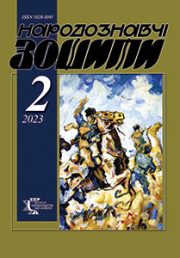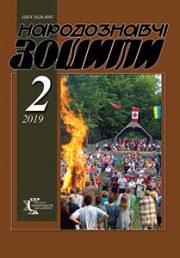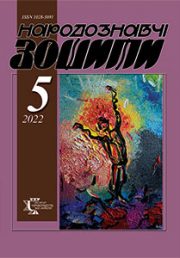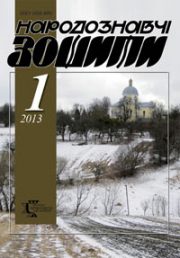The Ethnology Notebooks. 2022. № 6 (168), 1439—1447
UDK: 232.931:398.332.39:264-94(477)(045)”18/20″
DOI https://doi.org/10.15407/nz2022.06.1439
DYAKIV Volodymyr
- ORCID: https://orcid.org/0000-0002-9513-4364
- PhD of Philological Sciences, Senior Researcher Fellow
- of the Ethnology Institute of the
- National Academy of Sciences of Ukraine,
- 15, Svobody Avenue, 79008, Lviv, Ukraine,
- Lviv Polytechnic National University,
- department of the Ukrainian language
- Institute of Humanities and Social Sciences,
- 12, Bandera street, 79013, Lviv, Ukraine
- Contacts: e-mail: d.v.m.1029@gmail.com
Abstract. Introduction. The article’s relevance is determined by the need to investigate the folk-religious beliefs and ideas of Ukrainians related to the feast of the Nativity of the Mother of God in the context of the prerequisites of the pre-Christmas-New Year period in calendar rituals.
Problem Statement. The object of the study is the folk calendar rites of Ukrainians associated with the feast of the Nativity of the Mother of God, in particular, the traditional calendar rites of Ukrainians in the context of the prerequisites of the pre-Christmas and New Year period. The subject of the study is specific manifestations of folk Christian religiosity in this ritual.
The article focuses on covering the ethnographic regions of Ukraine in the period of the first half of the 19th to the beginning of the 21st century.
Purpose. The outlined work aims to single out folk-religious ideas and beliefs, characteristics of the traditional early winter period, to determine the traditional basis and innovative changes, features of the development of ideological content, and structural components, elements, and details.
Methods. The article mainly uses comparative-typological and historical-cultural methods, as well as elements of structural-typological, geographical, and other methods of ethnological science.
Results. Based on archival and field sources, as well as scientific literature, the development of a particular folk religiosity in the traditional calendar rites of Ukrainians in the context of the prerequisites of the pre-Christmas and New Year period is analyzed on the example of the feast of the Nativity of the Mother of God.
Conclusion. The beginning of the prerequisites of the pre-Christmas and New Year period in the traditional calendar rituals of Ukrainians is observed already in the autumn period, in particular, on the feast of the Nativity of the Mother of God. Against the background of the prerequisites of the pre-Christmas and New Year period, specific development of a peculiar folk religiosity is observed in the traditional calendar rituals of Ukrainians. This is confirmed by folk-religious ideas and beliefs, characteristics of the traditional early winter period, strict compliance of due respect to the saint, and appropriate celebration of the Nativity of the Mother of God, etc. In these fundamentally traditional ideas and beliefs of Ukrainians, a particular development of specific folk-religious components can be clearly traced.
Keywords: the Nativity of the Mother of God, folk religiosity, calendar rituality, tradition, beliefs, functioning.
Received 18.10.2022
REFERENCES
- Dyakiv, V. (2019). Feast of saint Simeon: folk religiosity in traditional calendar ritualism of Ukrainians against the background of pre-New Year and pre-Christmas period. The Ethnology Notebooks, 2 (146), 293—302. DOI: 10.15407/nz2019.02.293 [in Ukrainian].
- Dyakiv, V. (2019, october). The feast of St. Michael’s: folk religiosity against the background of pre-New Year and pre-Christmas period of calendar ritualism of Ukrainians. SWorld Journal: International periodic scientific journal. Indexed in INDEX COPERNICUS (Issue 2, part 3, pp. 66—76). Bulgaria: D.A. Tsenov Academy of Economics — Svishtov. DOI: 10.30888/2410-6615.2019-02-03-001 [in Ukrainian].
- Dyakiv, V. (2019, october). The feast of St. Michael’s: folk religiosity against the background of pre-New Year and pre-Christmas period of calendar ritualism of Ukrainians. SCIENCE FOR MODERN HUMANITY: Conference proceedings. Indexed in INDEX COPERNICUS (Pp. 94—96). Bulgaria: SWorld & D.A. Tsenov Academy of Economics — Svishtov [in Ukrainian].
- Kylymnyk, S. (1963). The Ukrainian year in folk customs in historical light: in V t. Winnipeg; Toronto, 1963. T. V: Autumn cycle. 288 p.
- Voropai, O. (1958). Customs of our people. Ethnographic essay. Munich: Ukrainian Publishing House, 1958. Volume II. 290 p. Toronto [in Ukrainian].
- Word of St. Gregory. Retrieved from: http://litopys.org.ua/oldukr2/oldukr14.htm (Last accessed: 11.09.2022).
- Word of St. Gregory. (2000). Christianity on the territory of Ukraine in the Ist—XIth centuries. Ukraine on the pages of the Holy Scriptures and excerpts from primary sources testifying to the process of the spread of Christianity on the territory of Ukraine from the Apostle Andrew to Prince Volodymyr. Kyiv [in Ukrainian].
- The word spoken by the Khrystoliubets. Retrieved from:http://litopys.org.ua/oldukr2/oldukr15.htm (access date: 11.09.2022).
- Kolodny, A. History of religion in Ukraine: in 10 vol.Kyiv: Ukrainian Center of Spiritual Culture, 1996. T. 1. P. 327.
- Tikhonravov, N. Words and teachings directed against pagan beliefs and rituals. Annals of Russian literature and antiquity, published by Nikolay Tikhonravov. Moscow, 1862. T. IV. P. 83—112.
- Ponomarev, A. «To the studies against ancient Russian paganism» by P.V. Vladimirova. Monuments of ancient Russian teacher’s literature. St. Petersburg, 1897. Issue III. P. 316—322
- Hrushevs’ky, M. (1993). History of the Ukrainian literature (Vol. I). Kyiv [in Ukrainian].
- Onyschuk, A. (1912). Folk calendar. Customs and beliefs are tied to single days of the year, recorded in 1907—10 in Zelenytsia, Nadvirnyansky district. Antin Onyshchuk, people. teacher. Materials for Ukrainian ethnology. Lviv, 1912. T. XV. P. 1—61. L’viv [in Ukrainian].
- Shekeryk-Donykiv, P. (2009). The year in Hutsul beliefs. Selected works. Verkhovyna: Editorial office of the journal (publishing house) «Hutsulshchyna», 2009. 352 p. [in Ukrainian].
- Agapkina, T.A., Valencova, M.M., Plotnikova, A.A., & Tolstoy, N.I. (Ed.). (2009). Nativity of the Virgin. Slavic antiquities (Vol. 4). Moscow: International Relations [in Russian].







